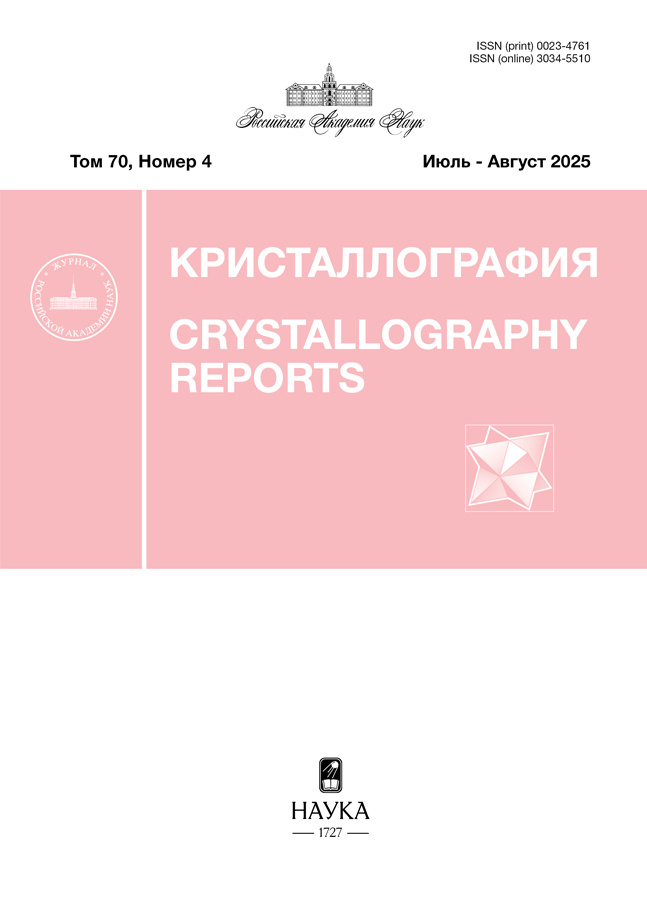X- ray diffraction analysis revealed the role of the L254 residue in the recognition of the substrate by carboxypeptidase T from Thermoactinomyces vulgaris
- Authors: Akparov V.K.1, Timofeev V.I.1, Konstantinova G.E.1, Kuranova I.P.1
-
Affiliations:
- National Research Center “Kurchatov Institute”
- Issue: Vol 70, No 4 (2025)
- Pages: 604–612
- Section: КРИСТАЛЛОГРАФИЯ В БИОЛОГИИ И МЕДИЦИНЕ
- URL: https://clinpractice.ru/0023-4761/article/view/688084
- DOI: https://doi.org/10.31857/S0023476125040099
- EDN: https://elibrary.ru/JGBDMH
- ID: 688084
Cite item
Abstract
Crystal structures of complexes of the mutant protein L254N carboxypeptidase T from Thermoactinomyces vulgaris with stable transition state analogues -N- sulfamoyl-L-glutamate, N-sulfamoyl-L-arginine, N-sulfamoyl-L-valine and N-sulfamoyl-L-leucine (resolution 2.05, 1.89, 2.30, 1.79 Å) were obtained. The dependence of the association constants of these inhibitors, as well as the efficiency of catalysis of the corresponding tripeptide substrates ZAAX, on the distances between the atoms of the ligand O15, O16, O20, T19 and the active center of the mutant protein N146, Y225 and E277 was found. This dependence differs significantly from the previously identified dependence for wild-type carboxypeptidase T. The results obtained indicate the involvement of leucine 254, which is part of the mobile loop of metallocarboxypeptidases, in the discrimination of substrates by carboxypeptidase T according to the induced fit mechanism.
Full Text
About the authors
V. Kh. Akparov
National Research Center “Kurchatov Institute”
Author for correspondence.
Email: valery.akparov@yandex.ru
Shubnikov Institute of Crystallography of the Kurchatov Complex Crystallography and Photonics
Russian Federation, MoscowV. I. Timofeev
National Research Center “Kurchatov Institute”
Email: valery.akparov@yandex.ru
Shubnikov Institute of Crystallography of the Kurchatov Complex Crystallography and Photonics
Russian Federation, MoscowG. E. Konstantinova
National Research Center “Kurchatov Institute”
Email: valery.akparov@yandex.ru
Shubnikov Institute of Crystallography of the Kurchatov Complex Crystallography and Photonics
Russian Federation, MoscowI. P. Kuranova
National Research Center “Kurchatov Institute”
Email: valery.akparov@yandex.ru
Shubnikov Institute of Crystallography of the Kurchatov Complex Crystallography and Photonics
Russian Federation, MoscowReferences
- Song J.J., Hwang I., Cho K.H. et al. // J. Clin. Invest. 2011. V. 121. № 9. P. 3517. https://doi.org/10.1172/JCI46387
- Vendrell J., Querol E., Avilés F.X. // Biochim. Biophys. Acta. 2000. V. 1477. № 1–2. P. 248. http://www.sciencedirect.com/science/article/pii/S0167483899002800
- Estell D., Graycar T., Miller J. et al. // Science. 1986. V. 233. P. 659. https://www.science.org/doi/10.1126/science.233.4764.659
- Wells J., Powers D., Bott R. // Proc. Natl. Acad. Sci. USA. 1987. V. 84. № 5. P. 1219.
- Hedstrom L., Szilágyi L., Rutter W.J. // Science. 1992. V. 255. P. 1249. https://doi.org/10.1126/science.1546324
- Hedstrom L., Farr-Jones S., Kettner C. et al. // Biochemistry. 1994. V. 33. № 29. P. 8764. https://doi.org/10.1021/bi00195a018
- Gul S., Pinitglang S., Thomas E. et al. // Biochem. Soc. Trans. 1998. V. 26. № 2. P. 171. https://doi.org/10.1042/bst026s171
- Akparov V.Kh., Timofeev V.I., Konstantinova G.E. et al. // PLoS One. 2019. V. 14. № 12. P. 1. https://doi.org/10.1371/journal.pone.0226636
- Stepanov V.M. // Methods Enzymol. 1995. V. 248. P. 675. https://doi.org/10.1016/0076-6879(95)48044-7
- Osterman A.L., Stepanov V.M., Rudenskaia G.N. et al. // Biokhimiia. 1984. V. 9. № 2. P. 292. https://www.ncbi.nlm.nih.gov/pubmed/6424730
- Grishin A.M., Akparov V.K., Chestukhina G.G. // Biochem. Moscow. 2008. V. 73. № 10. P. 1140. https://doi.org/10.1134/s0006297908100118
- Akparov V.K., Grishin A.M., Yusupova M.P. et al. // Biochem. Moscow. 2007. V. 72. № 4. P. 416. https://doi.org/10.1134/s0006297907040086
- Ho S.N., Hunt H.D., Horton R.M. et al. // Gene. 1989. V. 77. № 1. P. 51. https://doi.org/10.1016/0378-1119(89)90358-2
- Cueni L.B., Bazzone T.J., Riordan J.F., Vallee B.L. // Anal. Biochem. 1980. V. 107. № 2. P. 341. https://doi.org/10.1016/0003-2697(80)90394-2
- Battye T., Kontogiannis L., Johnson O., Powell H. //Acta Cryst. D. 2011. V. 67. № 4. P. 271. https://doi.org/ 10.1107/S0907444910048675
- Rimsa V., Eadsforth T.C., Joosten R.P., Hunter W.N. // Acta Cryst. D. 2014. V. 70. № 2. P. 279. https://doi.org/10.1107/S1399004713026801
- Murshudov G.N., Vagin A.A., Dodson E.J. // Acta Cryst. D. 1997. V. 53. № 3. P. 240. https://doi.org/10.1107/S0907444996012255
- Emsley P., Cowtan K. // Acta Cryst. D. 2004. V. 60. № 12. P. 2126. https://doi.org/10.1107/S0907444904019158
- Pauling L. // Chem. Eng. News. 1946. V. 24. № 10. P. 1375. https://doi.org/10.1021/cen-v024n010.p1375
- Wolfenden R. // Mol. Cell. Biochem. 1974. V. 3. № 3. P. 207. https://doi.org/10.1007/BF01686645
- Akparov V., Timofeev V., Kuranova I., Khaliullin I. // Crystals. 2021. V. 11. № 9. P. 1088. https://doi.org/10.3390/cryst11091088
Supplementary files














